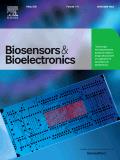- 投稿方式--官网投稿
-
期刊属性
-
- 中科分区:1区
- OA期刊:混合
-
- 综述期刊:否
- TOP期刊:是
-
- 期均国文:19
- 环比增速:15.38%
-
期刊信息
- 研究方向:工程技术-BIOPHYSICS生物物理;BIOTECHNOLOGY APPLIED MICROBIOLOGY生物工程与应用微生物;CHEMISTRY, ANALYTICAL分析化学;ELECTROCHEMISTRY电化学;NANOSCIENCE NANOTECHNOLOGY纳米科技
- 国际刊号:ISSN 0956-5663;EISSN 1873-4235
-
- 期刊语言:英语
- 出版地区:荷兰
- 投稿网址:https://www.editorialmanager.com/biosbe/default.aspx
- 电子邮箱:
- 期刊官网:https://www.journals.elsevier.com/biosensors-and-bioelectronics
- 作者指南:
- 出版商网址:http://www.elsevier.nl
- 出版地址:OXFORD FULFILLMENT CENTRE THE BOULEVARD, LANGFORD LANE, KIDLINGTON, OXFORD, ENGLAND, OXON, OX5 1GB
- 期刊简介:BIOSENSORS & BIOELECTRONICS《生物传感器与生物电子学》(半月刊). Biosensors & Bioelectronics is the principal international journal devoted to research, design, development and application of biosensors and bioelectronics. It is an interdisciplinary journal serving professionals with an interest in the exploitation of biological materials and designs in novel diagnostic and electronic devices including sensors, DNA chips, electronic noses, lab-on-a-chip and μ-TAS. Biosensors usually yield a digital electronic signal which is proportional to the concentration of a specific analyte or group of analytes. While the signal may in principle be continuous, devices can be configured to yield single measurements to meet specific market requirements.
-
万维提示
-
1、投稿方式:在线投稿。
2、期刊网址:
https://www.journals.elsevier.com/biosensors-and-bioelectronics
https://www.sciencedirect.com/journal/biosensors-and-bioelectronics
3、投稿网址:
https://www.editorialmanager.com/biosbe/default.aspx
4、期刊刊期:半月刊,每月1日、15日出版。
2022年1月1日星期六
投稿须知【官网信息】
Aims and Scope
Biosensors & Bioelectronics has an open access mirror journal, Biosensors & Bioelectronics:X.
Biosensors & Bioelectronics is the principal international journal devoted to research, design, development and application of biosensors and bioelectronics. It is an interdisciplinary journal serving professionals with an interest in the exploitation of biological materials and designs in novel diagnostic and electronic devices including sensors, DNA chips, electronic noses, lab-on-a-chip and μ-TAS.
Biosensors are defined as analytical devices incorporating a biological material (e.g. tissue, microorganisms, organelles, cell receptors, enzymes, antibodies, nucleic acids, natural products etc.), a biologically derived material (e.g. recombinant antibodies, engineered proteins, aptamers etc) or a biomimic (e.g. synthetic receptors, biomimetic catalysts, combinatorial ligands, imprinted polymers etc) intimately associated with or integrated within a physicochemical transducer or transducing microsystem, which may be optical, electrochemical, thermometric, piezoelectric, magnetic or micromechanical (Turner et al., 1987; Turner, 1989). Biosensors usually yield a digital electronic signal which is proportional to the concentration of a specific analyte or group of analytes. While the signal may in principle be continuous, devices can be configured to yield single measurements to meet specific market requirements. Examples of Biosensors include immunosensors, enzyme-based biosensors, organism- and whole cell-based biosensors. They have been applied to a wide variety of analytical problems including uses in medicine, biomedical research, drug discovery, the environment, food, process industries, security and defence. The design and study of molecular and supramolecular structures with molecular biorecognition and biomimetic properties for use in analytical devices is also included within the scope of the journal. Here the focus is on the complementary intersection between molecular recognition, nanotechnology, molecular imprinting and supramolecular chemistry to improve the analytical performance and robustness of devices.
The emerging field of Bioelectronics seeks to exploit biology in conjunction with electronics in a wider context encompassing, for example, biological fuel cells, bionics and biomaterials for information processing, information storage, electronic components and actuators. A key aspect is the interface between biological materials and micro- and nano-electronics.
While endeavouring to maintain coherence in the scope of the journal, the editors will accept reviews and papers of obvious relevance to the community, which describe important new concepts, underpin understanding of the field or provide important insights into the practical application, manufacture and commercialisation of biosensors and bioelectronics.
Types of papers
Full papers should describe original research work not previously published, and should be complete descriptions of full investigations comprising around 5000 words and with up to 6 figures and/or tables.
Short Communications should be concise but complete descriptions of original limited investigations comprising around 3000 words with up to 3 figures and/or tables.
Review Articles should present a thorough and comprehensive overview of the chosen subject and be extensively referenced and comprise around 8000-10000 words. Authors are expected to go beyond a simple compilation of references and analyse trends, shortcomings and accomplishments in their chosen field, charting possible future directions of the research. Illustrations and summary tables are encouraged. Flexibility of presentation is permitted, but authors are urged to arrange the subject matter clearly under the general headings of Abstract, Keywords, Introduction, Main text (The heading and the sub-headings of the main text are left to author's discretion), Summary and Conclusions, Future Perspectives, Acknowledgements, References. When writing reviews authors should take proper account of all the literature especially recent papers published over the past five years. Exceptions to these criteria may be permitted if you discuss your requirements in advance with an Editor.
If you wish to submit a review to the journal and have not been invited by one of the Editors, please first submit a short proposal using the standard review proposal template directly to the journal editorial system selecting Review Article as Article Type. Only once you have received approval and invitation from an Editor that your proposal has been accepted should you submit your paper to the journal. All reviews should be submitted via Editorial Manager and will be subject to the normal peer review process.
……
更多详情:
https://www.elsevier.com/journals/biosensors-and-bioelectronics/0956-5663/guide-for-authors
- Contemporary Physics《当代物理学》
- Discrete Analysis《离散分析》
- Chemical Industry & Chemical Engineering Quarterly《化学工业与化学工程
- ARP Rheumatology《ARP风湿病学》(原:Acta Reumatologica Portuguesa)
- ZFW-Advances in Economic Geography《ZFW:经济地理学进展》(原:Zeitschrif
- Yale Journal of Biology and Medicine《耶鲁生物学与医学杂志》
- Turkish Journal of Zoology《土耳其动物学杂志》
- Turkish Journal of Veterinary & Animal Sciences《土耳其兽医与动物科学杂志
- The Turkish Journal of Pediatrics《土耳其儿科杂志》
- Turkish Journal of Medical Sciences《土耳其医学杂志》
- Reproductive Sciences《生殖科学》
- Rejuvenation Research《抗衰老研究》
- Die Radiologie《放射学》(原:Der Radiologe)
- Quarterly Reviews of Biophysics《生物物理学评论季刊》
- Psychiatry and Clinical Neurosciences《精神病学与临床神经科学》
- Preventive Veterinary Medicine《预防兽医学》
- Physics of Particles and Nuclei《粒子核物理学》
- Numerical Linear Algebra with Applications《数值线性代数及其应用》
- Nanoscale and Microscale Thermophysical Engineering《微/纳尺度热物理
- Matrix Biology《基质生物学》

